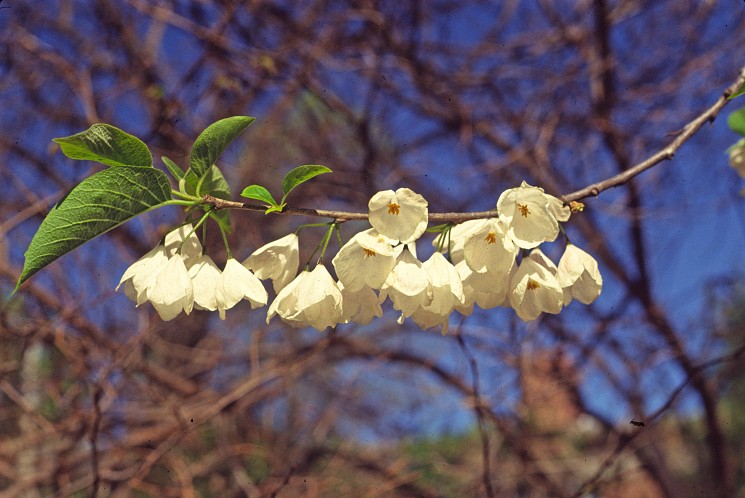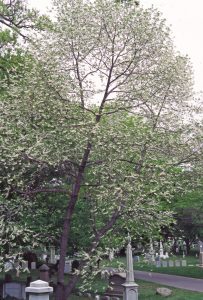Carolina Silverbell, Halesia tetraptera

Mary, Mary, quite contrary
Mother Goose
How does your garden grow?
With silver bells and cockleshells…
Contrarian or not, there are many gardeners and non-gardeners alike who would find that any gardens grow exquisitely fine if they include Carolina Silverbell, Halesia tetraptera. This mid-size tree, 30-40-feet tall (occasionally up to 80-feet) is native from West Virginia to Florida and west to Oklahoma. When in flower later in the month of May, these trees are often profusely bejeweled with dangling white, ½ to ¾-inch, bell-shaped flowers, beginning just before the trees leaf out and lasting for perhaps two weeks. The effect of viewing a good-sized, leafless tree covered with white flowers often stops visitors mid-stride. An ensuing curious effect occurs as the wilting flowers fall within the canopy envelope creating a snow-like appearance surrounding the base of the tree’s trunk.
Within the plant aficionados’ curious game of “who grows in your garden?”, the genus commemorates the English clergyman, naturalist, Stephen Hales (1677-1761). Hales was a respected member of the Royal Society for four decades. He won the Copley Medal in 1739, the oldest surviving scientific award in the world, which recognizes outstanding achievements in research in any branch of science. His plant physiology research published in his Statical Essays, included the results of experiments on water movement in plants, now understood as cohesion theory. Within animal physiology, he made the first measurements of blood pressure and correctly described heart valves during systole and diastole. He also developed early types of ventilators to improve air quality in closed spaces.
The genus Halesia with just four (or five) species, three from southeastern North America and one from southeastern China, was first described in the 1750’s, by the British merchant, naturalist, John Ellis (1710-1776), who used Carolina Silverbell as the type specimen. Ellis was a correspondent with Carl Linnaeus (1707-1778) and this type specimen was included in the 1758 10th edition of Linnaeus’ Systema Naturae.
With at least ten Silverbells growing at Mount Auburn, on your May visits, look for them flowering on Indian Ridge Path, Fountain Avenue, Kalmia Path, Aronia Path, Lantana Path, Wistaria Path, Jasmine Path, Galax Path, Pheasant Path and/or Bobolink Path.






…The tree-toads started ringing
Louis Untermeyer
Their ceaseless silver bells;
A land-locked breeze came swinging
Its censer of earthly smells…

Leave a Reply